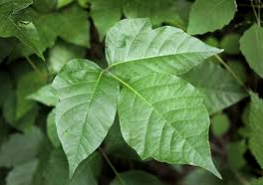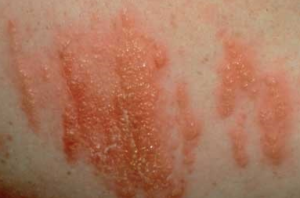
It’s that time of year again. It’s time to get out and about to enjoy some of the warm weather while it lasts. Whether you choose to spend your time relaxing in the backyard or adventuring up a mountainside on a hike, there are always things you should be on the lookout for. Poison ivy is a common outdoor hazard that many people encounter every year. This plant can cause problems when touched so knowing how to identify it and knowing what to do if you come in contact with the plant is key.
What is Poison Ivy?

The easiest way to keep from getting a rash from poison ivy is to avoid touching it, but certainly that can be easier said than done. Poison ivy has three leaves so avoiding all plants with three leaves on the stem is a good start. Remember the saying “leaves of three, leave it be.” The plant has an oil on its leaves called, urushiol. This oil can cause an itchy, blistering rash, redness, and hives when it touches skin. This rash can be delayed, however. Some people don’t experience symptoms until 12-72 hours after coming into contact with the plant. While direct contact with the leaves can result in a rash, other common ways people come into contact with poison ivy are:
- Indirect contact- oil from the plant is transferred from another object or animal. This can be any object that has touched the plant or a pet that has the oil on their fur. Don’t worry pet lovers, animals do not get the rash.
- Airborne contact- burning poison ivy can release the plant’s oil into the air. The oil can then land on skin and cause a rash.
Tips for Dealing with the Rash

One strategy that can potentially prevent the rash after coming into contact with poison ivy is to wash the area with soap and water to try to remove the oil. This is not always effective and people still can get the rash. There are products available that can be used to remove the oil after it is on the skin (Zanfel, Tecnu, etc.). These can be tried but they have not been shown to be more effective than soap and water. More information can be found on each products website (linked below). The rash usually goes away over a few weeks but there are products that can be used to relieve the symptoms. Products called astringents, such as Domeboro, calamine lotion, and oatmeal baths, can help relieve itching caused by the rash. Over the counter hydrocortisone can also be used if the rash is mild. More severe cases may require prescription medications. Medical attention may be required immediately for some poison ivy exposures. Seek medical attention if:
- There is difficulty swallowing, breathing, or swelling of face
- The rash covers a large portion of your body
- The rash has not improved or has worsened after a week of treatment
- If the rash is on a child less than 2 years of age
If you are unsure about which products to use to treat your poison ivy rash or whether further medical attention is required, Bremo Pharmacy can help answer your questions. Our contact page is linked below. We have three locations with pharmacists that can help.
Hopefully these tips will help you have an enjoyable summer and avoid dealing with poison ivy, but if not, you will have the knowledge of how to manage the rash. Resources with more information are linked below:
Patient Resources:
- Bremo Pharmacy. https://bremorx.com/contact/
- American Academy of Dermatology. https://www.aad.org/public/diseases/itchy-skin/poison-ivy-oak-and-sumac#overview
- Tecnu Product. https://www.teclabsinc.com/products/poison-oak-ivy/tecnu
- Zanfel Product. https://www.zanfel.com/help
References:
- Poison Ivy, Oak, and Sumac. American Academy of Dermatology. Accessed: 8/13/18. https://www.aad.org/public/diseases/itchy-skin/poison-ivy-oak-and-sumac#overview
- Help Clarify the Role of OTC and Rx Options for Poison Ivy. Pharmacist Letter. 8/2017. https://pharmacist.therapeuticresearch.com/Content/Articles/PL/2017/Aug/Help-Clarify-the-Role-of-OTC-and-Rx-Options-for-Poison-Ivy
Jansen Morrison, PharmD candidate 2019


